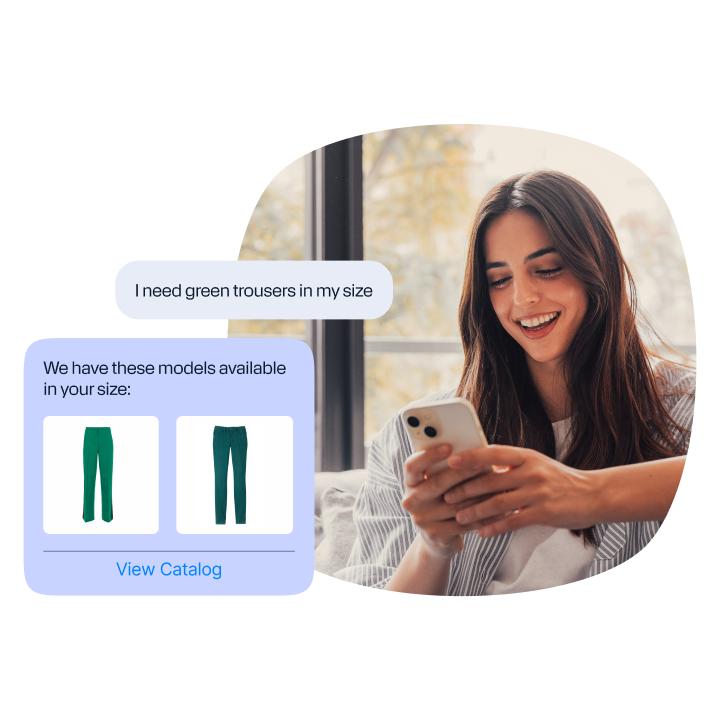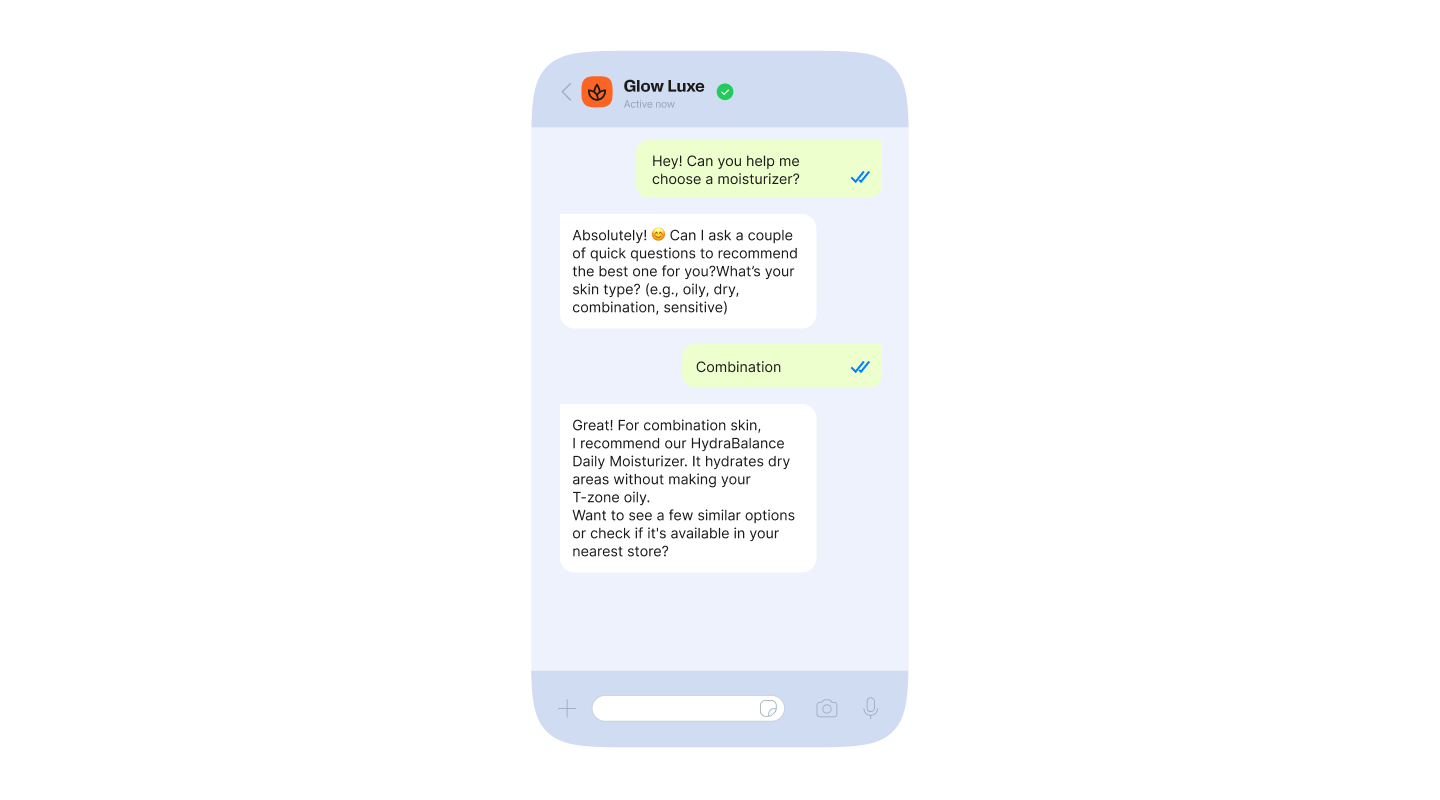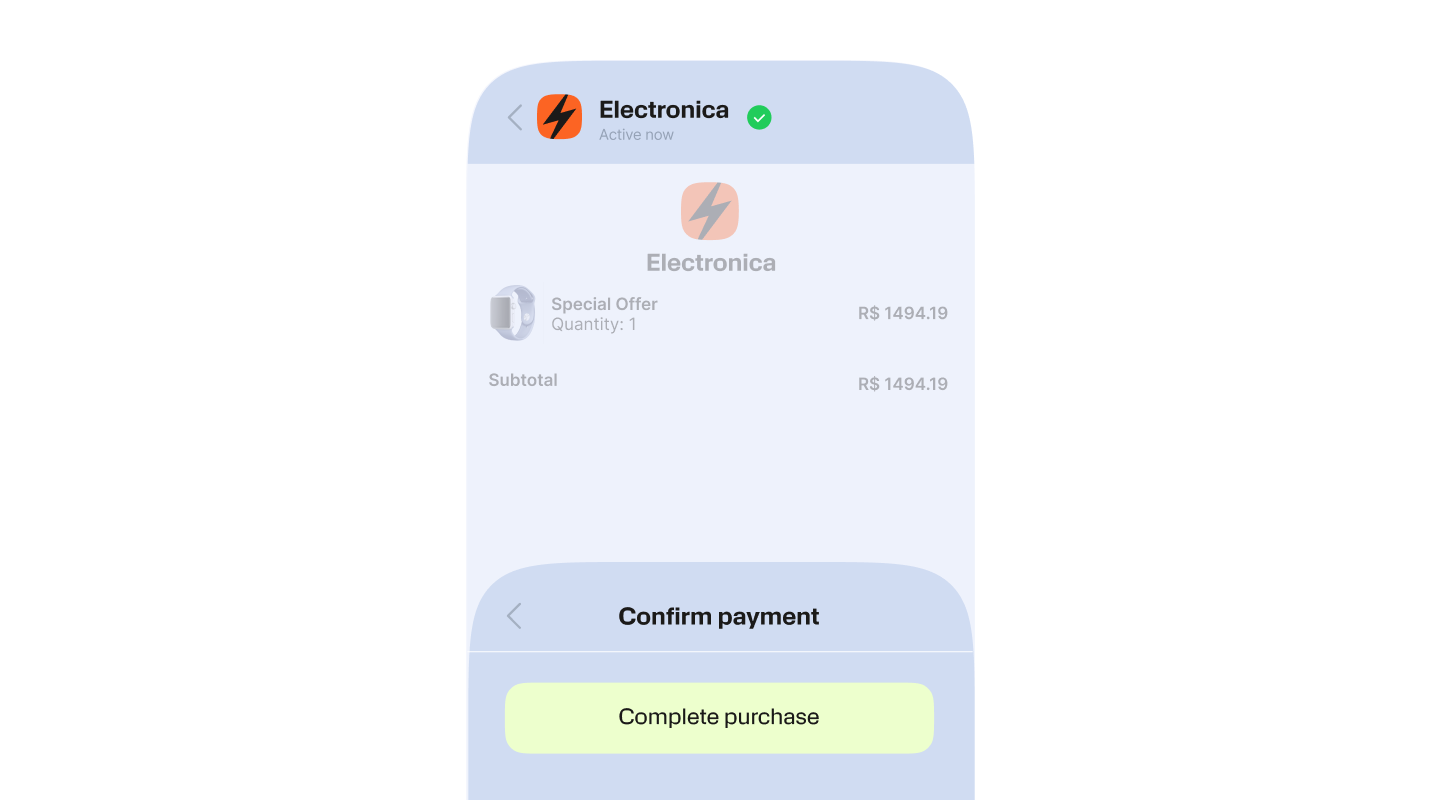Conversational commerce in retail: Benefits, strategies, and examples
Learn what conversational commerce is in retail, how retailers can capitalize on it, and what the benefits are.

We’ve previously explained everything you need to know about conversational commerce. But that’s conversational commerce as a concept. And as a concept, it’s subject to slight variations across industry-specific implementations.
What is conversational commerce in retail?
Conversational commerce in retail implies integrating all systems necessary to facilitate the creation of complete conversational customer journeys over messaging channels in real time.
A simple example of this would be conducting a complete transaction over a chat app, instead of through your web store or shopping app.
How does this work in practice? What does conversational commerce look like for retailers and eCommerce companies? How can you build conversational customer journeys and know whether you’re doing it right?
We break down each of these points in the sections below.
The rise of conversational commerce in retail
A few key factors fuel this growth.
- Cost reduction: Businesses can reduce customer service costs by upwards of 30% using chatbots. This is because conversational chatbots can handle the most common customer queries.
- Technological advancements: Advancements in AI, machine learning, and natural language processing are enabling the creation of powerful chatbots that reframe customer service capabilities. More recently, agentic AI and retrieval-augmented generation (RAG) have further advanced these capabilities, allowing chatbots to autonomously complete multi-step tasks and access real-time data and knowledge when serving customers.
- Customer expectations: 71% of customers expect personalized communications from brands and get frustrated when they don’t receive them. Over 50% of customers expect a business to be available 24/7. Conversational commerce systems can satisfy these customer demands, making for good CX, higher customer satisfaction (CSAT), and increased loyalty.
- Data-driven personalization: Conversational commerce systems generate a wealth of data on customer interactions, preferences, and behaviors. This data can be used to deliver personalized experiences. For example: targeted product recommendations, customized offers, and proactive customer service. At the same time, conversational experience orchestration platforms (CXOP), like Infobip, are making it easier to unify and automate these data-driven journeys across every retail channel.
Benefits of conversational commerce in retail
Conversational commerce excels at common retail-specific use cases. Starting with:
Reducing cart abandonment
According to the Baymard Institute, the average documented online shopping cart abandonment rate is 70.19%. Brands lose around $18 billion in annual sales revenue to cart abandonment every year. Of this total, $260bn is recoverable.
Conversational commerce reduces cart abandonment by essentially removing the cart. Conversational commerce enables smoother checkouts by removing friction points in the traditional eCommerce journey.
Customers complete purchases right within the app, where their conversations begin.
Buyers don’t need to move from browsing windows toward carts and then go through all the steps needed to complete a transaction.
Instead, transactions are quick and easy with the push of a button, getting around the typical customer journey sticking point that results in cart abandonment.
Retailers and eCommerce companies can steer their conversational channels to re-target customers with products left in their carts.

Booking deliveries and returns
Deliveries are a common customer service issue. The problem is that retailers don’t handle shipping. But they do handle unhappy customers who want to know when they can expect their package.
With conversational commerce systems, retailers can change that. They can integrate with shipping companies to pull data and provide customers with instant delivery status updates.
This applies to both buying and returning products. Customers can schedule a pickup and return via the same retailer-integrated delivery service via chat.
This makes for a far smoother customer experience (CX) than dealing individually with the retailer and delivery services.

Enhancing customer service
Retailers can significantly improve the shopping experience by offering category-specific catalogs to customers through messaging platforms like Messenger and WhatsApp. Conversational AI plays a crucial role in this process. It automates product discovery and offers relevant suggestions based on real-time queries and browsing history.
Shoppers can browse entire product catalogs without leaving the chat app, where they can even complete their purchase.

Increasing sales
Whatever your transaction may be, from buying limited edition lipstick to booking an Uber, the ability to complete it within a messaging app defines conversational commerce.
Some messaging channels directly access payment systems, such as WhatsApp and Apple. Other channels can integrate with third-party POS processors to facilitate quick and easy in-chat payments.
This removes friction from the checkout process, reducing cart abandonment and ultimately increasing sales. It also improves CX, which results in heightened, longer-lasting loyalty.

Conversational commerce use cases across retail
Now that we’ve seen the benefits, let’s see how conversational commerce works in practice.
Personalized shopping assistants
Chatbots and AI interfaces act as virtual personal shoppers, offering tailored recommendations and guidance. For example, ASOS uses chatbots to actively search for items on your behalf. The chatbot can:
- Recommend items based on your style
- Browse items from specific brands you love (i.e., have interacted with in the past)
- Have a set budget for the items it recommends

Customer support and FAQs
Conversational commerce streamlines customer support by providing instant answers to frequently asked questions. Retailers can automate:
- Responses to inquiries about order status
- Shipping information
- Product details
While human agents can focus on more complex issues.
For instance, Airport AI’s chatbot efficiently managed routine inquiries, including flight information, booking confirmations, and baggage inquiries, delivering instant and accurate responses 24/7.

Post-purchase support and feedback collection
Chatbots are extending support beyond the point of purchase, assisting with returns, tracking orders, and collecting valuable feedback. For example, Amazon’s chatbot helps customers track orders and manage returns. The chatbot provides:
- Real-time updates on shipment status
- Guides users through the return process
- Generates return labels and schedules pickups
- Seamless checkout experience

Seamless checkout experience
Chatbots simplify the checkout process, guiding customers through each step, answering questions, and enabling secure transactions. Domino’s Pizza chatbot, known as “Dom,” simplifies the ordering process by allowing customers to:
- Place orders
- Track deliveries
- Repeat previous orders
Customers can place orders directly through messaging platforms like Facebook Messenger or WhatsApp, without visiting the website or app.

Creating a unique retail experience for every step of the customer journey
The underlying technology of conversational commerce facilitates hyper-personalized customer journeys.
Conversational commerce technologies can quickly access and analyze customer data across various touchpoints to:
- Provide proactive customer service: Retailers can predict why customers contact them using contextual data from various sources. This could be because of late delivery or providing item information following delivery, just in case anything is wrong.
- Offer relevant product recommendations: Offering irrelevant products can drive customers away. Conversational commerce technologies can immediately fetch and analyze customer browsing and purchase history to recommend complementary products, helping to build stronger customer relationships.
- Upselling and cross-selling: Goes hand-in-hand with offering relevant product recommendations and complementary products. Conversational commerce enables brands to deliver context-aware upselling moments at just the right time in the customer journey. The key difference is that it feels like a personal recommendation, not just a generic ‘customers also bought’ section.
- Complete checkout: With payment integrations, customers can quickly and securely complete purchases in the same chat app where they started.
Because conversational technology can instantly access and analyze customer data profiles, shoppers can enjoy hyper-personalized experiences that are quick and convenient.
How to start with conversational commerce in retail
Choose a conversational commerce platform
Start by considering which conversational commerce platform offers the features you need to provide complete conversational customer journeys.
Start by looking at what you already have integrated with your systems and whether these can be used with your conversational commerce platform.
Specifically, consider whether your existing systems can “speak with” your new conversational commerce platform. Otherwise, you risk relying on incomplete customer data profiles that are not populated from other customer lifetime touchpoints. This results in poor customer experience (CX).
Also, check if you can process payments in your region. There’s no point building a full journey if payments aren’t supported.
For example, building conversational commerce on a channel without product catalogs or in-app payments might not be the best use of resources.
Choose the right channel
Retailers commonly focus on developing conversational commerce capability for the channels with the highest customer engagement.
This might not be the best approach.
While channel engagement is an otherwise important KPI, channel functionalities play a more important role in conversational commerce.
The optimal approach is to strike a balance between customer habits and channel functionality.
For example, building conversational commerce on a channel without product catalogs or in-app payments might not be the best use of resources.
Examples of platforms that enable conversational commerce in retail
- Chatbots: These programs simulate human conversation, guiding customers and offering support. They’re efficient and require less labor than live chat.
- Live chat: Provides real-time access to human support, allowing for more personalized engagement and effective conversions.
- SMS: Boasts a high open rate but requires concise, relevant messaging to avoid unsubscribed.
- Voice assistants: Use voice recognition and AI to interact with customers, similar to chatbots but solely through sound.
- RCS: Enables rich media messages, branded sender IDs, interactive buttons, and seamless two-way conversations, all delivered natively in customers’ messaging apps.
- WhatsApp: is a widely used platform with over 2 billion users. Its business API offers businesses opportunities for customer engagement and sales.
- Messenger: Another popular platform with a potentially different target audience, still presenting strong sales potential.
By considering customer preferences and the specific functionalities of messaging apps and social media platforms, you can ensure an efficient shopping experience.
Choosing the right conversational commerce tools, such as chat automation platforms, AI-powered analytics, and payment-integrated messaging APIs, can significantly improve operational efficiency and customer satisfaction.

Define your conversational commerce strategy
Consider what part of your retail business your conversational commerce system will cover and develop in that direction.
This should factor in the basics like channel capabilities and tone of voice, as well as more complex issues. This includes, for example, how conversational commerce will work with your sales and marketing strategy.
Will the role be more focused on resolving customer service issues? Maybe the idea is to boost sales or guide customers through common sticking points in the customer journey, or all three?
Design your conversational commerce strategy to complement your existing strategies. Your choice of conversational commerce tools should align with your broader sales and support goals. Whether that means focusing on chatbot functionality or investing in robust analytics.
As your system learns from more interactions, it will be able to handle a wider range of tasks.
Incorporating agentic AI can help align your system to proactively achieve business goals, such as revenue targets or engagement rates, by autonomously triggering actions and campaigns in response to customer behavior.
Plan a conversational flow
This step involves understanding your customers’ journey with you.
Identify at which stage of the customer journey conversational interaction begins. Start planning how your chatbot will interact from this point and the actions it takes.
This results in a guided customer journey optimized to fit your strategy.
Train your chatbot
Start with a basic set of responses and actions will yield basic results. Conversational chatbots need to be trained to understand a broader sample of customer intents.
You can achieve this by programming chatbots to understand several phrase variations for each customer intent.
Ongoing training helps AI learn new customer intents through machine learning.
Monitoring interactions is also crucial since it helps identify and address any problematic areas where customers may drop off.
Advanced conversational AI frameworks make it easier to scale and optimize these interactions, allowing chatbots to evolve from basic automation to sophisticated, human-like assistants.
Combining RAG with agentic AI in chatbot training brings both up-to-date knowledge and the ability to perform complex, multi-step tasks, ensuring your bot grows in both capability and intelligence.
Test your conversational commerce solution
Before unleashing your conversational commerce solution, take a test drive of your solution as a customer. This will let you identify areas of improvement and shake out any bugs.
It also gives you the unique opportunity to experience your customer journey from a shopper’s point of view. This is a valuable opportunity to evaluate and potentially further optimize parts of your customer journey.
Conversational commerce retail KPIs
It can be difficult to know what impact your conversational commerce system has on your business when you’re starting. Here are some helpful KPIs to look for specific to conversational commerce in retail.
- Conversion rates: How many conversations are resulting in completed customer journeys, i.e., resulting in a sale.
- Cart abandonment rates: Monitor the number of customers who drop out of the customer journey before completing a conversion on both your conventional and conversational sales channels.
- Goal completion rates: Depending on how you use your conversational commerce system, what comprises a “goal completion” may vary. For some use cases, the goal could be to just resolve customer service queries, for example.
- Customer satisfaction scores: Ask customers for feedback in the same chat by sending a survey. Alternatively, you can ask customers to rate their satisfaction across key CSAT components with a 1-10 rating.
- Average response time: Monitor the time it takes your conversational system to reply to customer inquiries. Additionally, collect averages across customer service teams to see the impact on this crucial customer satisfaction stat.
- Average conversation length: This KPI is a double-edged sword. It might show strong engagement or point to inefficiencies. Again, consider what your system is designed for. If your goal is fast support, shorter times are better. But if you’re aiming for more engaging experiences, longer conversations can be a good sign.
Several conversational commerce success KPIs need to take into account the purpose of your conversational chatbot within your sales strategy. What one business case may consider a success, another may see as a conversational system underperforming. Consider your case when gauging across these metrics.

The next step for retailers and eCommerce companies
Trends show that commerce is moving towards messaging apps. Customers are looking for the personalized feel of an in-shop experience delivered over a single channel from the comfort of their own couch.
Retailers and eCommerce companies sell more, faster, with comparatively lower overhead than it would require to staff teams around the clock.
Starting in conversational commerce is more straightforward than it may seem.
Retailers need to start developing their conversational channels to prepare for the shift towards more conversational commerce. The ideal starting point is to automate customer service inquiries with a machine learning AI conversational chatbot.
This way, you’ll teach your chatbot how to understand the most common customer intents, while machine learning will help it understand more and broader intents over time.
For those aiming to become market leaders, the next evolutionary step is integrating agentic AI for truly autonomous customer assistance, RAG for real-time, reference-backed answers, and CXOPs to orchestrate every step of the journey, helping retailers stay agile as customer expectations continue to rise.
In time, your system will develop into a conversational commerce system capable of managing entire customer journeys, from entry to past conversions to customer service and back again.
FAQs on conversational commerce in retail
Conversational commerce uses messaging apps, chatbots, and AI-driven platforms to guide shoppers through personalized, interactive buying journeys, instead of relying solely on static web stores or apps.
It enables customers to check out and get support directly within messaging channels, removes friction, and uses AI-powered reminders and incentives to close more sales.
Key metrics include conversion rate, cart abandonment reduction, customer satisfaction scores (CSAT), average response time, repeat purchase rate, and overall sales growth.
Begin by automating your most common customer service queries with a chatbot, then scale up by adding AI, payment integrations, and orchestration tools as you learn from customer interactions.
Keep reading:

Best SMS marketing software & platforms: Top choices in 2025.
Here’s a breakdown of the most important features you might be looking for, and how top SMS marketing platforms compare.
- Best Practices.
- SMS.
- Marketing.

Make every season count: A strategic guide to seasonal marketing.
Learn how to create compelling marketing campaigns that resonate with your audience, regardless of the season.
- Best Practices.
- Marketing.

Multichannel communication in 2025: Why it's time to move beyond it.
Multichannel communication is siloed, and it no longer meets what customers want. Here's why.
- Best Practices.
- Conversational experience.

What is phygital marketing? 11 examples of phygital experiences.
Let's explore everything you need to know about phygital marketing and how it can help you build a successful marketing strategy.
- Blog.
- Inspiration.
- People CDP – customer data.

Serial returners and the future of eCommerce: A guide for businesses.
Discover the impact of serial returners on businesses. Learn the reasons behind excessive returns and how they affect your bottom line.
- Best Practices.
- Answers – Chatbot Builder.
- Moments – Customer Engagement.
- People CDP – customer data.
- eCommerce.
- Retail.

Hirt & Carter: The future of retail is unified.
Experience the future of retail with Hirt & Carter. Learn how they are adapting to the digital age to provide personalized and engaging customer journeys by leveraging the partnership with Infobip.
- Blog.
- Best Practices.
- Spotlight.
- Retail.

eMAG: eCommerce success with an omnichannel approach.
Learn how EMAG maintains its status as Romania's most popular eCommerce platform by providing the products that people want to buy and a customer experience that keeps them coming back.
- Blog.
- Inspiration.
- SMS.
- Partnership.
- Spotlight.
- eCommerce.

Alyasra Fashion: Building strong customer relationships through personalization.
Alyasra Fashion is setting new customer satisfaction and convenience standards with its personalized approach. Learn how.
- Blog.
- Trends and Insights.
- eCommerce.
- Spotlight.
- eCommerce.

How Carrefour is transforming the shopping experience with conversational retail.
Carrefour is leveraging conversational retail to transform the way we shop. Dive into the new era of customer service and personalized interactions.
- Blog.
- Inspiration.
- Conversational experience.
- Spotlight.
- Retail.








